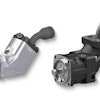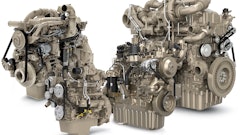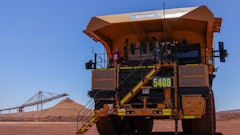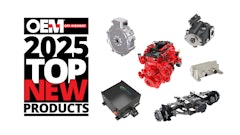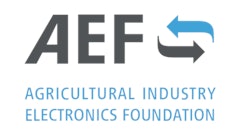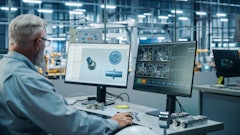
Electrification has always been a major aspect of off-highway vehicles and technology and recent trends have made it even moreso. The mining, agriculture and construction industries are grappling with changes and challenges to the power grid and how their vehicles are powered. This is even more acute with the tide shifting towards alternative energy and fuels as a viable source in certain applications.
These industry experts on the off-highway industry offered their insights on electrification in a roundtable format:
- Lloyd Gomm, global director marketing, ZAPI GROUP
- Brady Lewis, P.E., manager, emerging products & technology, CASE Construction Equipment
- Athan Tsokolas, product manager - commercial Lithium-ion batteries, Vanguard
- Chris Wadsworth, VP and GM, global OEM, Wesco.
Question: What trends do you see in integrating augmented reality (AR) and virtual reality (VR) into training and operations?
Lloyd Gomm: There are three trends that stand out:
- Improving safety – AR and VR eliminate risks of on-site training for heavy machinery; operators can practice in realistic simulations without endangering personnel or equipment.
- Enabling remote operations – VR-controlled systems enable fully remote vehicle operation, improving efficiency in hazardous environments, expanding the available labor pool, and allowing human intervention at critical automation checkpoints.
- Enhancing operator effectiveness – AR-powered heads-up displays can provide real-time, intuitive data overlays to assist with complex tasks and further improve safety.
Question: How are HMI advancements transforming the operator experience in off-highway vehicles?
Lloyd Gomm: Electrification significantly enhances HMI by integrating the entire vehicle into a seamless, data-driven ecosystem. Operators receive real-time feedback on system performance, allowing instant detection of faults or unsafe operating conditions and reducing the risk of human error. Advanced HMI thus enhances:
- Safety
- Efficiency
- Ease of use.
Question: What are the most impactful innovations in telematics and IoT for off-highway vehicles?
Lloyd Gomm: AI-powered analytics continue revolutionizing the industry by systematically identifying and eliminating efficiency bottlenecks. Cloud-based analytics and 5G connectivity further enable over-the-air (OTA) software updates and automated fault detection.
Brady Lewis: Telematics has a huge potential to improve the customer experience, especially for large fleet operators. There are some innovative customers who are pushing the boundaries of what is possible, but a lot of the customers we talk to are still working to fully implement the technology. For several years now, CASE Construction has included telematics hardware and subscription services on every product sold in North America. And we are working with our dealers and customers to utilize the system and take advantage of the information it brings. As we expand this group of engaged users, we are using that knowledge and working to improve the telematics capabilities of both the vehicles and operators.
Athan Tsokolas: Telematics and IoT are transforming off-highway vehicles by providing valuable insights into machine operation and performance. Our BMS plays a key role by collecting and transmitting data on critical parameters like battery health, state of charge and temperature. The data empowers users to understand how their equipment is being used, optimize performance and proactively address potential issues.
This enhanced visibility leads to better decision-making, improved maintenance scheduling and increased operational efficiency. As technology evolves, we anticipate even more sophisticated telematics and IoT solutions that will further enhance the productivity and cost-effectiveness of off-highway electric equipment.
Question: How is the integration of AI and machine learning transforming equipment performance and efficiency?
Lloyd Gomm: By applying machine learning in combination with optimization techniques such as genetic algorithms and predictive modeling, it is possible to develop vehicle systems capable of making decisions based on previous data.
The staggering implications of this already see testing in agricultural applications, with AI-powered models quantifying factors such as:
- Soil sinkage, stress, and density
- Rut depth and contact area
- Energy loss in traction.
Such data will prove invaluable in optimizing future vehicle performance, allowing for improved maneuverability across terrains, minimized vehicle wear, and better power distribution.
Machine learning models could see similar applications in other verticals.
Chris Wadsworth: AI and machine learning have incredible potential, but we’re just at the beginning. AI will be added to products and machine learning will support autonomous vehicles, but getting better results from these technologies should be the goal. Iteration will be the key to improving performance and efficiency, and provide a reduction in total cost of ownership over time.
Question: How are electronic systems improving predictive maintenance and reducing equipment downtime?
Lloyd Gomm: AI-powered predictive maintenance leverages sensor diagnostics and condition monitoring to anticipate the failure or breakdown of key components (and relay necessary data when breakdowns do happen) much more precisely to individual machines. This allows fleet managers to anticipate, plan, and execute maintenance with minimal downtime at scale.
Question: What role do advanced diagnostics tools play in the lifecycle management of off-highway machinery?
Lloyd Gomm: Diagnostic tools enable a proactive (rather than reactive) approach to lifecycle management. As digitalization expands, fault codes and real-time monitoring provide precise insights into servicing needs, allowing issues to be identified before they escalate. Integration with onboard systems also allows for remote troubleshooting, minimizing onsite visits along with associated downtime and cost.
Question: How is IoT being used to improve fleet management and operational efficiency in off-highway applications?
Lloyd Gomm: It is helping in two ways:
- Strategic decision-making – IoT-powered fleet analytics scales data-driven insights to fleet-wide levels, refining operations with real-time fuel use, efficiency, and performance parameters.
- Advancing autonomy – Genuine autonomy (rather than monitored operations) promises to skyrocket efficiency. With autonomous vehicles comprising the fastest-growing IoT cluster, such a future may not be far off.


